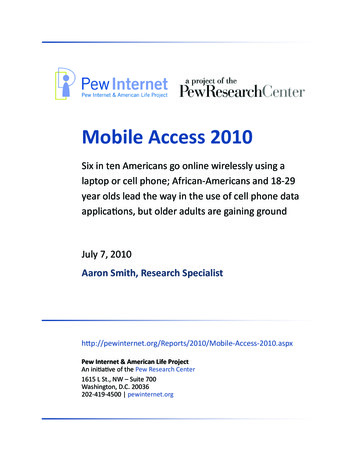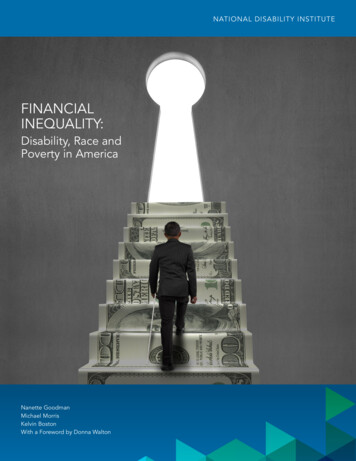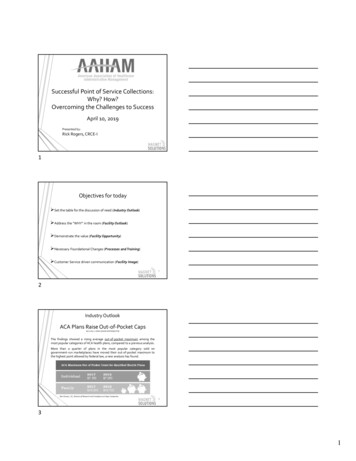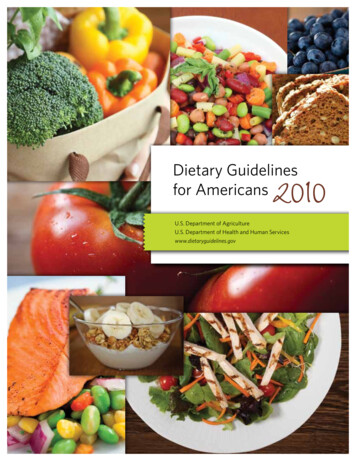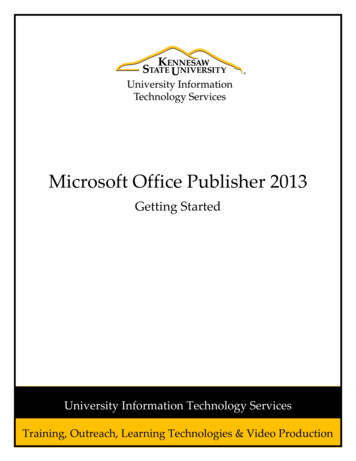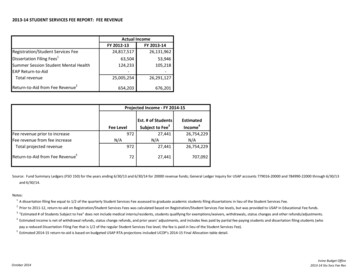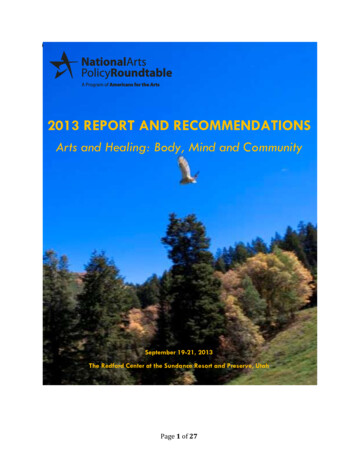
Transcription
i2013 REPORT AND RECOMMENDATIONSArts and Healing: Body, Mind and CommunitySeptember 19-21, 2013The Redford Center at the Sundance Resort and Preserve, UtahPage 1 of 27
Table of ContentsA Message from Robert Redford and Robert L. Lynch. 3Overview: . 4Background: . 5Roundtable Panels and Presentations: . 6Arts and Healing in the Military . 6The Art of Health Maintenance: A Public Health View . 10Creative Approaches to Healing: . 12Healing the Mind and Body . 14Art and Healing of Communities . 17Inocente: Screening and Discussion . 20Breakout Sessions. 201. Art in the Digital World . 202. Arts in the Military and the VA . 213. Using Metrics . 214. Society’s Role . 21Outcomes and Recommendations . 22Conclusion: . 22ABOUT THE NATIONAL ARTS POLICY ROUNDTABLE . 24About Americans for the Arts . 25About Sundance Institute . 25APPENDIX A: National Arts Policy Roundtable participants . 26Page 2 of 27
A Message from Robert Redford and Robert L. LynchWe founded the Americans for the Arts National ArtsPolicy Roundtable at Sundance Resort together in 2006,as a place to engage high-level leaders fromgovernment, business, arts and the social sectors in notonly talking about big ideas—but envisioning new waysto engage in action to advance the arts and ourAmerican society. Since then more than 250 decisionmakers and thought leaders have convened in spiriteddiscussion and debate. Significant and measurable policy achievements at the national, state, andlocal levels have resulted from each convening.The 2013 topic, Arts and Healing: Mind, Body and Community proposed that the arts can play animportant role in the rehabilitation of those who have experienced both mental and physicaltraumas, including our nation’s wounded servicemen and women.In the process, we werereminded again that challenge is really just another name for opportunity.The Roundtable participants, who come from a variety of sectors, discussed ways in which the artscan assist individuals and communities—working in partnership with foundations, business, andgovernment entities—to develop locally-based solutions. Our goal was to generate specific,actionable policy recommendations—and to extend them to the appropriate leaders in both thepublic and private sectors. This report is the result, and action toward change has already begun.Thanks are due to Founding National Arts Policy Roundtable Chair Marian Godfrey. We aregrateful to Americans for the Arts staff members Nora Halpern, Vice President of LeadershipAlliances and Christine Meehan, Manager of Leadership Alliances as well as Keri Putnam,Executive Director of the Sundance Institute for their leadership in realizing this program.Finally, we thank the participants both at the Policy Roundtable itself as well as the participants ofthe 2013 Aspen Seminar for Leadership in the Arts. The ideas gathered from both conveningsinformed our action and outcomes and have launched us into new ways of thinking and viewing thetopic at hand. We appreciate the time, expertise and insight that all of the participants provided.We hope this report will provoke further thought and continued discussion, and lead to collectiveaction among all leaders, across all sectors, in building a healthy, vibrant America through the arts.Robert RedfordFounder, Sundance InstituteRobert L. LynchPresident and CEO, Americans for the ArtsPage 3 of 27
Finally, what is it we can leave here with? The country is so wounded, bleeding, and hurt rightnow. The country needs to be healed—it’s not going to be healed from the top, politically. Howare we going to heal? Art. Art is the healing force.”-Robert Redford, 2012 National Arts Policy Roundtable closing remarksOverview:Robert Redford’s concluding comments from the 2012 National Arts Policy Roundtable served asthe springboard for the 2013 topic and the premise that the arts, resonating deeply with thehuman experience, are saturated with the potential to promote healing and wellness, not only inhospitals and other healthcare facilities, but also within the fabric of our communities.The 2013 National Arts Policy Roundtable convened around the idea that the arts have thecapacity to drive the healing process, building healthier individuals and stronger communities.Countless programs and initiatives are already underway, and there is a growing willingnessamong medical and military professionals, as well as society as a whole, to further integrate artsand healing. Using existing programs and research as a starting point, the charge for the 2013National Arts Policy Roundtable was to discuss how we can help society better understand thehealing power of the arts and how we can more deeply integrate arts and healing across a rangeof spectrums, including medicine, public health, the military, and community development.A fit and strong nation is dependent upon the overall mental and physical health of its citizens.When a population is truly healthy, it is better poised to build strong communities, foster a thrivingeconomy, increase productivity, and innovate towards an improved communal future.The scope and breadth of America’s health challenges are vast. Thousands of patients suffer froma wide range of physical and psychological conditions as our healthcare system struggles to keepapace with the development and administration of treatments. With the wars in Iraq andAfghanistan drawing to a close, a new set of health concerns weighs upon society; the wave ofreturning service members includes many suffering from physical and emotional traumas, as well asfamilies, communities, and a society needing ways to process and heal. Given the complexity andscale of these issues, it is clear that traditional Western medicine alone is no longer sufficient toheal both civilian and military patients.We have also seen, over the years, entire communities in our country, suffering from manmade andnatural disasters, including 9/11, Hurricanes Katrina and Sandy, the 2013 Boston bombings, andthe Newtown shootings, as well as from social fractions and inter-community tensions. In thesevulnerable times, communities need ways to express grief and to develop a shared spirit ofresolve. Is there a role that the arts can play in treating these conditions and promoting the healthand resiliency of individuals and communities?Today, there is a growing awareness of the intricate relationship between the healing process andthe arts. Medical professionals and arts leaders are researching and documenting the ways inwhich the creative process impacts the treatment of disease, prospects for recovery, and even theprevention of illness. Arts practitioners, including creative arts therapists, artists, educators, and artsorganizations have worked to provide programs, as well as expressive, therapeutic, andeducational services, to engage patients, as well as caregivers, and promote an active recoveryprocess.Page 4 of 27
Background:In 2004 and 2007, Americans for the Arts partnered with the Society for the Arts in Healthcare toconduct surveys that examined the prevalence of arts programming in American healthcaresettings. These surveys found that nearly half of the civilian hospitals in the U.S. offer on-siteprogramming for their patients and staff. Results also show that there has recently been a growthin the prevalence of art in healthcare facilities, as well as significant increases in organizationalsupport for these programs. Why have hospitals placed a growing value on arts and healingprograms?Why Healthcare Institutions Invest in the Arts 2009 Americans for the Arts, Society for the Arts in HealthcareIncorporating creative arts therapies (music, visual art, dance, poetry, drama) into rehabilitativesettings promotes both physical and psychological healing. Studies indicate that art can increasepatients’ overall health outcomes, treatment compliance, and quality of life across a wide array ofhealth conditions—from post-traumatic stress disorder to autism, mental health, chronic illnesses,Alzheimer’s and dementia, neurological disorders including brain injuries, as well as physicaldisabilities.ii By stimulating the body’s senses and organizing the brain’s functions, art therapyproduces positive neurological effects for both pediatric and adult patients.iii Creative artstherapy and creative arts expression can also alleviate the burden of chronic disease and otherillnesses by uplifting the spirit and enabling patients to communicate emotions and experiencesthat words alone cannot express. When patients feel positively about themselves, the body’snatural healing mechanism, the immune system, can better combat illness.iv Creative art therapycan also decrease anxiety, restore a patient’s emotional balance, and provide an outlet for selfexpression.vPage 5 of 27
The healing power of the arts extends beyond thetreatment of physical and psychological conditions.Communities worldwide have experienced therestorative benefits of the creative arts. Over theyears, the arts have been used to bridge socialdivides and heal communities in the aftermath ofnatural and manmade disasters. Participating in thearts provides a way for communities to expressthemselves in creative and collaborative ways andserves as a tool for enhancing the community’sunderlying identity.viAlthough current research and success stories point toart’s ability to heal mind, body, and community, muchwork still remains to raise awareness of its value. Ourtask is to show how the arts can contribute to thehealth and wellness of our nation, increasing theoverall vitality of our healthcare system and oureconomy and producing individual, community, andsocietal benefits.Roundtable Panels and Presentations:Arts, Healing, and EconomicsA growing body of researchdemonstrates the economic benefits ofincluding the arts in healthcare programs.Office visits and hospital stays areshorter and more efficient. Not onlydoes the patient benefit physically, buthealth costs go down, as well. Accordingto a 2008 study conducted atTallahassee Memorial HealthCare, usingmusic therapy to prepare children for CTscans significantly reduces the use ofsedative medications, associatedovernight stays, and nurse time, as wellas the need for repeat CTs from poorquality scans. Given these findings,researchers estimated a cost saving of 567 per procedure. If applied to the 4million pediatric CT scans conductedannually in the U.S., music therapy for thisprocedure alone could save 2.25 billionper year.Wood, B. (2008). CT scans and radiationArts and Healing in the Militaryexposure. AAP Grand Rounds, 19, 28–29.Focusing on the intersection between the arts and themilitary, the first panel presentation explored the roleart can play in facilitating service members’ reintegration into civilian life. Since September 11,2001, the United States has deployed more than two million service men and women to Iraq andAfghanistan. With these conflicts drawing to a close and troops returning home in high numbers,there is a growing awareness among the public and private sectors, as well as the military itself,that the challenges facing service members,Excerpts from ReEntryveterans, and their families require more thantraditional medical treatment. Over the pastKeri, USMC Corporal: How do I really feeldecade, members of the armed services havewhen people say thank you? What I want toendured extended and multiple deployments,say is, “You don’t even f*ing know butexposure to nontraditional combat, andyou’re welcome.shortened times between deployments. Giventhese unprecedented demands, the number ofTommy, USMC Staff Sergeant: Thank you forservice members returning home with bothwhat? For getting blown up? For being in thephysical and psychological traumas, includingwrong place at the wrong time? Or for doingPost-Traumatic Stress Disorder (PTSD), loss of awhat you wouldn’t go and do? Whatever.limb, brain injuries and depression, hasJust buy me a beer and we’ll call it even.increased. Is there a role that the arts can playRebecca, USMC 2nd Lieutenant: I guess onein helping individuals and society understand,of the reasons I get so uncomfortable whenadjust, and heal?people thank me is that I guess I feel guilty.Delving into this key question, the RoundtableI didn’t see the worst and I feel guilty aboutopened on the first evening with a powerfulthat.Page 6 of 27
excerpt from the play ReEntry, a drama that explores thechallenges faced by service members and their families uponreturn from combat. Presented by co-author and actor EmilyAckerman, as well as actors Larry Mitchell and BobbyMoreno, the excerpt effectively framed the arts and militaryissue, creating a wonderful jumping off point for the rest ofthe evening’s discussions.Based on actual interviews with members of the Marine Corpsand their family members, ReEntry presents real stories fromreal people, exploring the intimate emotional strugglesexperienced by service members, mothers, sisters, and others impacted by military service and itsaftermath. Informed by her brothers’ experiences with military service and PTSD, Ackerman cowrote ReEntry with actor and writer KJ Sanchez, in part, to help civilians understand the strugglesthat veterans encounter upon their return from combat.Although originally intended for civilian, rather than military, audiences, ReEntry has positivelyimpacted service members and their families and elicited needed policy changes to advance theintegration of arts and healing in military settings. After ReEntry’spremiere, the playwrights received a contract from the Department ofDefense to perform the play on military bases and hospitals in the“War is the mostU.S. and abroad. Shown as a post-deployment briefing tool, thedemanding and cruelestplay has educated civilians and service members alike aboutof all human endeavors,what to expect from family members and friends after returningand it affectsfrom war. These events, which feature a performance of theeveryone The arts canplay followed by a guided talkback, allow audience membersplay a huge role into open up and speak about emotions that might havehelpingthem [veterans]previously been inexpressible. The discussions, Ackerman toldbecomeproductiveNAPR participants, “gave people permission to talk in a groupplayers in our society.about things they weren’t talking about before—about things,they thought, only they felt.” Ackerman also learned that, after-Gen. George Caseywatching the performance, many of the service members and theirfamilies began talking about their experiences and seekingtreatment.The powerful performance of ReEntry led into a panel discussion about art’s ability to facilitate reintegration into civilian society. Moderated by National Arts Policy Roundtable facilitator, DavidGrant, the panel featured presentations by Emily Ackerman, co-author of ReEntry, GeneralGeorge W. Casey, Jr., 36th Chief of Staff of the U.S. Army (retired), Commander Moira McGuire,Program Manager of the Warrior Clinic and Lead forthe Creative Arts Program at the Walter Reed NationalMilitary Medical Center, and Dr. Tommy Sowers,Assistant Secretary for Public and IntergovernmentalAffairs at the U.S. Department of Veterans Affairs.Drawing from personal experience, the panelistshighlighted current and past efforts, including keyprograms and partnerships, to integrate the arts into themilitary. Using these initiatives as a starting point,panelists described the ways in which the arts can playan active, meaningful role in addressing a vast array ofPage 7 of 27
critical issues across the military continuum, whilehighlighting future opportunities for collaboration.The panelists echoed ReEntry’s message that, byproviding a platform for service members andveterans to tell their stories, art can serve as abridge to healing.General Casey provided a sobering overview of thevalue of incorporating art into military settings. Aftertwelve years of war, over 200,000 returning servicemen and women remain unemployed, 50,000 havebeen wounded, and 10,000 will require long-term care. Given these statistics, the scope anddegree of our challenges are formidable and pervasive. Because every person experiences adifferent challenge, we need to have many “tools in our kit bags” for dealing with the aftermathof war. Casey has learned that art, can serve as one of those critical tools by promoting physicaland mental rehabilitation for returning service members. “Everyone has a story to tell,” Casey said,and “art gives a medium for them to tell theirstory.” Through the healing process, art can How the Arts Can Aid Pre-Deploymenthelp veterans re-discover their place incivilian life and become engaged members After listening to presentations about arts andof their communities. Because “the aftermath healing in military settings, a number ofof this war is going to be with us for a long participants raised questions about the possibilitytime,” public-private partnerships with the of using art to prepare service members fordeployment. “We have talked about what to doarts community can provide critical support.post-deployment for the military, but is thereEmily Ackerman added that, in order to anything you can do to help service membersfacilitate reintegration into civilian life, we while they are still in the U.S.?” Lisa Leone, Vicemust communicate the struggles of service President of Artistic Programming at the Nationalmembers and veterans to the civilian YoungArts Foundation, asked. Actor Bobbypopulation. Because most Americans are Moreno added: “Is there a way to create an ‘artseither unaware of or do not regularly think bootcamp’ to get people ready before they goabout the struggles of the military community, into conflict?” In response these questions,service men and women often feel invisible, Commander McGuire suggested issuing journalsboth while serving and upon their return to to service members before deployment andcivilian life. To remove the ‘us versus them’ encouraging them to write about their thoughts,perception, we need to locate money, experiences, and emotions. Debra Polich, aresources, and opportunity to create a participant of the concurrent Executiveplatform for education.Leadership Forum, also recommended using artprograms to teach service members about theDiscussing the applications of Casey and cultural norms of the regions they will enter.Ackerman’spresentations,Commander Through cultural awareness training, we canMcGuire and Dr. Tommy Sowers highlighted prepare our service members for the sights theycurrent arts and healing programs sponsored will see, while setting the stage for betterby their respective agencies. McGuire traced interactions between Americans and localthe development and contributions of Walter civilians. General Casey added that, in order toReed’s Creative Arts Program, one of the enhance the acceptance of the arts as part of thenations’s leading arts and healing initiatives. healing and pre-deployment processes, we needSince its beginnings in 2003, the program has to bring down barriers and find a champion toenhanced the healing process for woundedpush forward these ideas.service members, family members and staff,Page 8 of 27
by providing access to a full spectrum of artsmodalities—from a performing arts series and artist inresidence programs to writing and music workshops. Byintegrating creative arts into a comprehensive patientcentered healthcare system, Walter Reed has served as aleader in arts and healing efforts, as well as in militarymedicine more broadly.The daughter of an opera singer father and a pianist,painter and playwright mother, McGuire grew up with adeep personal belief in and understanding of the valueof art. At the Warrior Clinic, she witnesses the healing power of art on a daily basis and hasworked, over the years, to educate others about art’s fundamental role in the treatment process.From her vantage point, McGuire has seen, first-hand, art’s unique ability to reveal emotions thathave been repressed. “When confronted with our emotions, we often shove them under the bed,”McGuire said. But, “at a certain point, you run out of room.” By participating in art therapy andcreative art programs, wounded service members and veterans take emotions out from “under thebed,” communicating previously inexpressible thoughts and developing the language to move pastfeeling isolated in their experiences.The VA has also made significant headway in developing arts and healing programs for veterans.Tommy Sowers discussed the agency’s efforts, as the largest integrated healthcare system in theUnited States, to incorporate creative expression into the healing process. Affirming his belief thatthe arts can “transport and teach us,” Sowers focused his discussion on the National VeteransCreative Arts Festival, an annual, weeklong event that showcases the creative achievements ofveterans receiving treatment at VA facilities. The culmination of talent competitions for veterans,the Festival features winning artworks—selected from 3,500 submissions in genres ranging fromthe visual arts and creative writing to dance, drama, and music—in a gala variety show. Theprogram aims to recognize the creative accomplishments of veterans and to educate communitiesthroughout the nation about the therapeutic benefits of the arts. By empowering veterans toexpress themselves through art, the program, according to Sowers, enables participants to “shineinside and out.” Recognizing the healing power of art, Sowers invites artists to use their craft andtalents to grow arts and healing programs and to engage wounded veterans through creativeexpression. “Pulling those stories out of veterans and getting them to communicate that’s a verypowerful thing where we need help,” Sowers concludes.To promote the expansion of creative arts programs, such as thoseWalter Reed and the VA, leaders in the military community havedeveloped partnerships with stakeholders in the public andprivate sectors to advance the integration of arts and health inthe military. McGuire highlighted one of these criticalpartnerships: the National Initiative for Arts & Healing in theMilitary, co-chaired by Walter Reed and Americans for theArts. Created in 2012, the Initiative represents the first timethat the military has joined with a coalition of civilian publicand private sector partners to ensure quality access to thearts for the health and well-being of service members,veterans, and their families.Page 9 of 27at“Pulling those stories outof veterans and gettingthem tocommunicate that’s avery powerful thingwhere we [the VA] needhelp.”-Dr. Tommy Sowers
Following a series of national convenings, which have brought together more than 500 thoughtleaders, practitioners and decision makers, the Initiative published its findings in a 2013 reportentitled Arts, Health, and Well-Being across the Military Continuum—White Paper and Framing aNational Plan of Action. The White Paper chronicles the more than 2-year investigation andnational conversation on how the arts help mitigate the challenges our military and veteranscommunities face. Providing a framework for how various stakeholders can work together toengage in greater cooperation, the report summarizes three critical areas of interest: research,policy, and practice. The recommendations issued by the White Paper are intended to stimulatefurther conversation and inspire action among stakeholders in the military and civilian communities.Although the idea of partnership, such as the one with Americans for the Arts, is a relatively newconcept for the military, McGuire is hopeful that we can continue to expand arts and healingprograms in military settings.For the first time, the idea that the arts can play an active role in the military is being addressedacross all sectors. Society has indicated the willingness to empathize with our service members andveterans, and military leaders have grown increasingly eager to explore new ideas and toengage in partnership with the civilian community. Given this growing awareness and a sense ofurgency to produce change, we must continue working together to expand arts and healingprograms for the benefit of our wounded warriors. “War is one of the most demanding and cruelof all human endeavors,” Casey concluded. In its aftermath, art can help create a sense ofrenewal for individuals, the military community, and society as a whole.The Art of Health Maintenance: A Public Health ViewRear Admiral Boris Lushniak, Acting United StatesSurgeon General, encourages creative arts practitionersand advocates to extend ‘arts and healing’ to ‘arts andprevention.’ He began this discussion by describing theNational Prevention Strategy, an inter-agency effortreleased in June 2011 that aims to improve healthoutcomes by shifting our nation’s healthcare focus fromsickness and disease to prevention and wellness. Art,Lushniak contends, plays a role in each of the four maincomponents of the Strategy: Healthy and SafeCommunity Environments, Clinical and Community Preventative Services,Empowered People, and Elimination of Health Disparities.Considered the Nation’s Doctor, the Surgeon General uses thebest scientific information available and translates andcommunicates it to the American public in an effort toprotect, promote and advance the health and safety ofour Nation. Recognizing the deep connection betweenthe arts and well-being, Lushniak celebrates art as apublic health tool rich with opportunity, not only in thehealing process, but also in the prevention of diseaseand illness.In the twenty-first century, “what I’m trying to achievefor public health—for healing and prevention—I can’t doPage 10 of 27“Much like we see art beingused in the international realmto transcend languages andcultures, art can be used withinthe confines of our own nation totranscend communities, using thesame international language toaffect those individuals.”-RADM Boris Lushniak
alone,” Lushniak affirmed. Given the growing complexities of our nation’s health challenges,including the physical and psychological conditions that plague our veteran population, themedical field “does not have all the pharmaceutical concoctions to make these problems all better.It’s not a matter of having a pill, an operation, or a device but these issues are still our problem.”To improve the well-being of individuals and communities, partners in various sectors and atdifferent levels of government must collaborate to bring down public health barriers for the goodof the nation and our global society. Because “all of us know that the arts are important to ourlives,” artists and arts organizations have the tools to serve as critical public health partners. Nomatter where you come from, Lushniak said, “You are an artist and part of the public healthcommunity. I am a physician, not an artist, but all of us are artists to an extent.”National Prevention Strategy ComponentsBecause health “does not begin and end in a doctor’s office,” but stems from physical, mental andsocial well-being, we should turn our attention to developing wellness before illness advances.Lushniak believes that art can help facilitate this transition by building resilience on both anindividual and a community level. In the same way that art has transcended languages as a toolfor international diplomacy, we can use the “international language of art” to bridge barriers inour communities and promote a healthier lifestyle for all Americans.Although arts practitioners and therapists have made great strides in integrating arts andhealthcare, Lushniak sees room for growth in the areas of both
disabilities.ii By stimulating the body's senses and organizing the brain's functions, art therapy produces positive neurological effects for both pediatric and adult patients.iii Creative arts therapy and creative arts expression can also alleviate the burden of chronic disease and other
